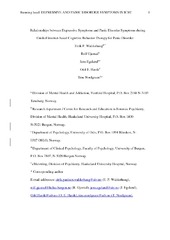| dc.contributor.author | Walderhaug, Eirik Paulsen | |
| dc.contributor.author | Gjestad, Rolf | |
| dc.contributor.author | Egeland, Jens | |
| dc.contributor.author | Havik, Odd E. | |
| dc.contributor.author | Nordgreen, Tine | |
| dc.date.accessioned | 2020-05-06T08:52:47Z | |
| dc.date.available | 2020-05-06T08:52:47Z | |
| dc.date.issued | 2019 | |
| dc.Published | Walderhaug EP, Gjestad R, Egeland J, Havik OE, Nordgreen T. Relationships between depressive symptoms and panic disorder symptoms during guided internet-delivered cognitive behavior therapy for panic disorder. Nordic Journal of Psychiatry. 2019;73(7):417-424 | eng |
| dc.identifier.issn | 0803-9488 | |
| dc.identifier.issn | 1502-4725 | |
| dc.identifier.uri | https://hdl.handle.net/1956/22105 | |
| dc.description.abstract | Aims: The current study explore the relationship between the trajectories of primary panic disorder symptoms and secondary depressive symptoms during guided internet-delivered cognitive behaviour therapy for panic disorder. Materials and methods: The patients (N=143) were recruited from an ongoing effectiveness study in secondary mental health outpatient services in Norway. Weekly self-reported primary panic disorder symptoms and secondary depressive symptoms were analysed. Results: primary panic disorder symptoms and secondary depressive symptoms improved significantly during the course of treatment, and at six months follow-up. Parallel process latent growth curve modelling showed that the trajectory of depressive symptoms and trajectory of panic disorder symptoms were significantly related. A supplementary analysis with cross-lagged panel modelling showed that (1) pre-treatment depressive symptoms predicted a positive effect of panic disorder symptoms early in treatment; (2) high early treatment panic disorder symptoms predicted low depressive symptoms at post-treatment. Conclusions: Guided ICBT for panic disorder is effective for both primary panic disorder symptoms and secondary depressive symptoms. Patients with high pre-treatment secondary depressive symptoms may constitute a vulnerable subgroup. A high level of panic disorder symptoms early in treatment seems beneficiary for depressive symptoms outcome. A time-dependent model may be necessary to describe the relationship between PAD symptoms and depressive symptoms during the course of treatment. | en_US |
| dc.language.iso | eng | eng |
| dc.publisher | Taylor & Francis | eng |
| dc.title | Relationships between depressive symptoms and panic disorder symptoms during guided internet-delivered cognitive behavior therapy for panic disorder | eng |
| dc.type | Peer reviewed | |
| dc.type | Journal article | |
| dc.date.updated | 2019-11-20T08:34:30Z | |
| dc.description.version | acceptedVersion | |
| dc.rights.holder | Copyright 2019 The Nordic Psychiatric Association | eng |
| dc.identifier.doi | https://doi.org/10.1080/08039488.2019.1646803 | |
| dc.identifier.cristin | 1714106 | |
| dc.source.journal | Nordic Journal of Psychiatry | |
| dc.relation.project | Norges forskningsråd: 259293 | |
